battery HONDA CLARITY ELECTRIC 2019 Owner's Manual (in English)
[x] Cancel search | Manufacturer: HONDA, Model Year: 2019, Model line: CLARITY ELECTRIC, Model: HONDA CLARITY ELECTRIC 2019Pages: 559, PDF Size: 28.11 MB
Page 4 of 559
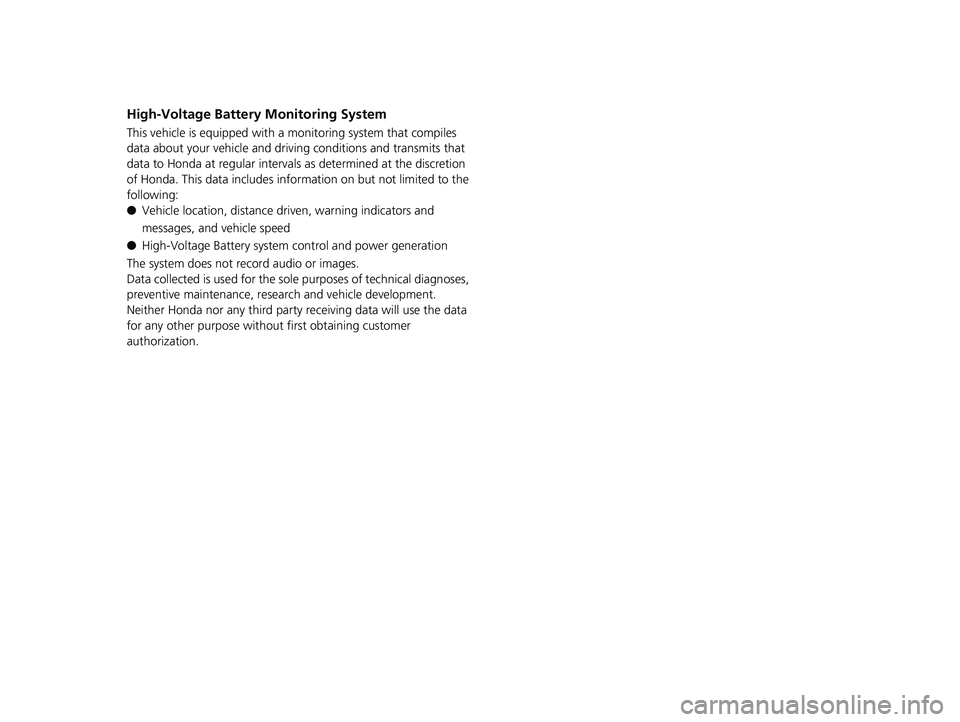
High-Voltage Battery Monitoring System
This vehicle is equipped with a monitoring system that compiles
data about your vehicle and drivin g conditions and transmits that
data to Honda at regular intervals as determined at the discretion
of Honda. This data includes information on but not limited to the
following:
● Vehicle location, distance dr iven, warning indicators and
messages, and vehicle speed
● High-Voltage Battery system control and power generation
The system does not record audio or images.
Data collected is used for the sole purposes of technical diagnoses,
preventive maintenance, resear ch and vehicle development.
Neither Honda nor any third party receiving data will use the data
for any other purpose withou t first obtaining customer
authorization.
19 CLARITY BEV-31TRV6200.book 2 ページ 2018年10月29日 月曜日 午前10時54分
Page 7 of 559
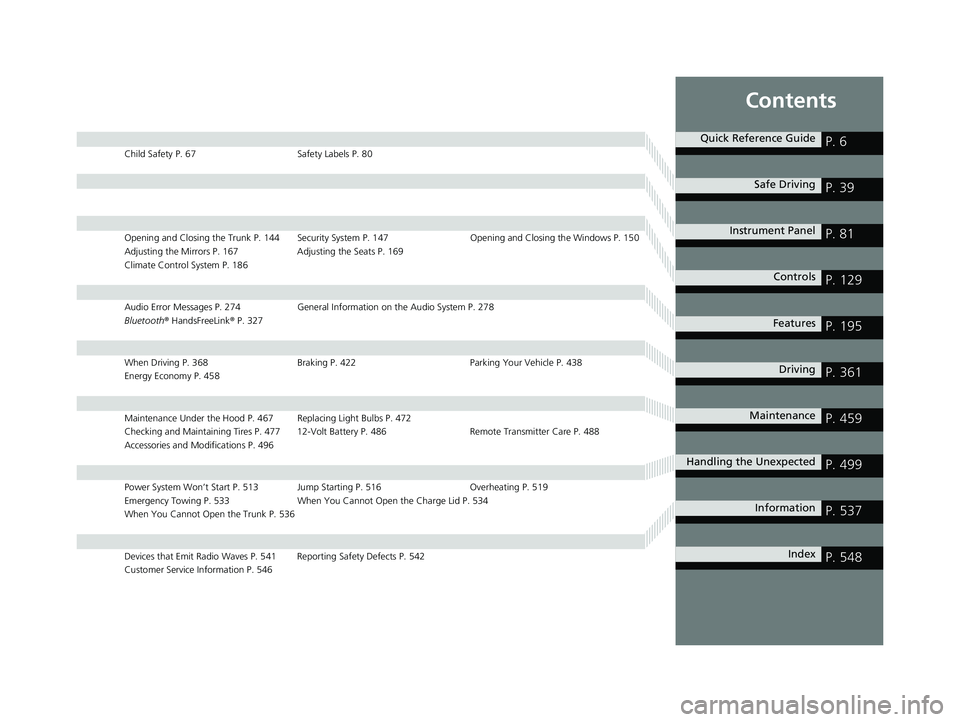
Contents
Child Safety P. 67Safety Labels P. 80
Opening and Closing the Trunk P. 144 Security System P. 147 Opening and Closing the Windows P. 150
Adjusting the Mirrors P. 167 Adjusting the Seats P. 169
Climate Control System P. 186
Audio Error Messages P. 274 General Information on the Audio System P. 278
Bluetooth ® HandsFreeLink ® P. 327
When Driving P. 368 Braking P. 422Parking Your Vehicle P. 438
Energy Economy P. 458
Maintenance Under the Hood P. 467 Replacing Light Bulbs P. 472
Checking and Maintaining Tires P. 477 12-Volt Battery P. 486 Remote Transmitter Care P. 488
Accessories and Modifications P. 496
Power System Won’t Start P. 513 Jump Starting P. 516 Overheating P. 519
Emergency Towing P. 533 When You Cannot Open the Charge Lid P. 534
When You Cannot Open the Trunk P. 536
Devices that Emit Radio Waves P. 541 Reporting Safety Defects P. 542
Customer Service Information P. 546
Quick Reference GuideP. 6
Safe DrivingP. 39
Instrument PanelP. 81
ControlsP. 129
FeaturesP. 195
DrivingP. 361
MaintenanceP. 459
Handling the UnexpectedP. 499
InformationP. 537
IndexP. 548
19 CLARITY BEV-31TRV6200.book 5 ページ 2018年10月29日 月曜日 午前10時54分
Page 15 of 559
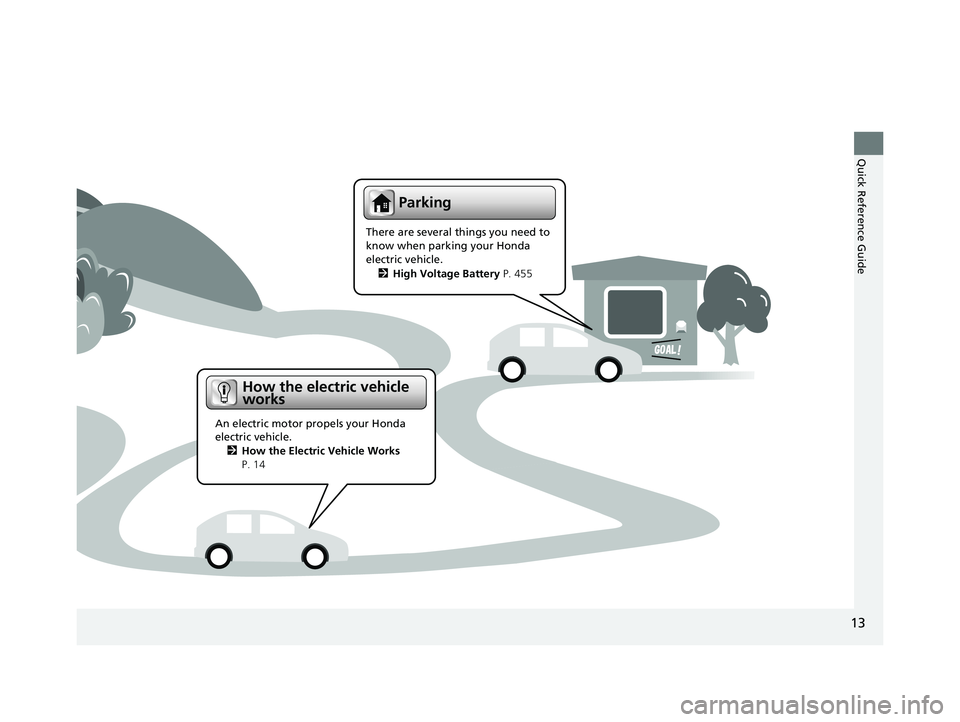
13
Quick Reference Guide
Parking
There are several things you need to
know when parking your Honda
electric vehicle.2 High Voltage Battery P. 455
How the electric vehicle
works
An electric motor propels your Honda
electric vehicle.
2 How the Electric Vehicle Works
P. 14
19 CLARITY BEV-31TRV6200.book 13 ページ 2018年10月29日 月曜日 午前10時54分
Page 16 of 559
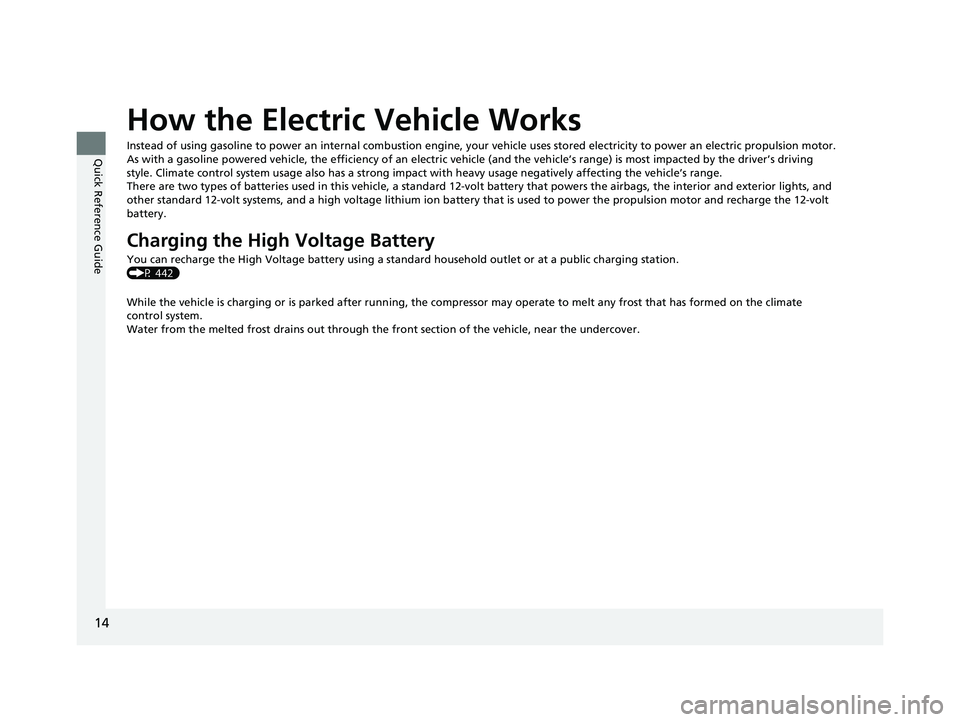
14
Quick Reference Guide
How the Electric Vehicle Works
Instead of using gasoline to power an internal combustion engine, your vehicle uses stored electricity to power an electric pro pulsion motor.
As with a gasoline powered vehicle, the efficiency of an electri c vehicle (and the vehicle’s range) is most impacted by the driver’s driving
style. Climate control system usage also has a strong impact with heavy usage negatively affecting the vehicle’s range.
There are two types of batteries used in this vehicle, a standa rd 12-volt battery that powers the airbags, the interior and exterior lights, and
other standard 12-volt systems, and a high voltage lithium ion ba ttery that is used to power the propulsion motor and recharge the 12-volt
battery.
Charging the High Voltage Battery
You can recharge the High Voltage battery using a standar d household outlet or at a public charging station.
(P 442)
While the vehicle is charging or is parked after running, the co mpressor may operate to melt any frost that has formed on the climate
control system.
Water from the melted frost drains out through the fr ont section of the vehicle, near the undercover.
19 CLARITY BEV-31TRV6200.book 14 ページ 2018年10月29日 月曜日 午前10時54分
Page 17 of 559
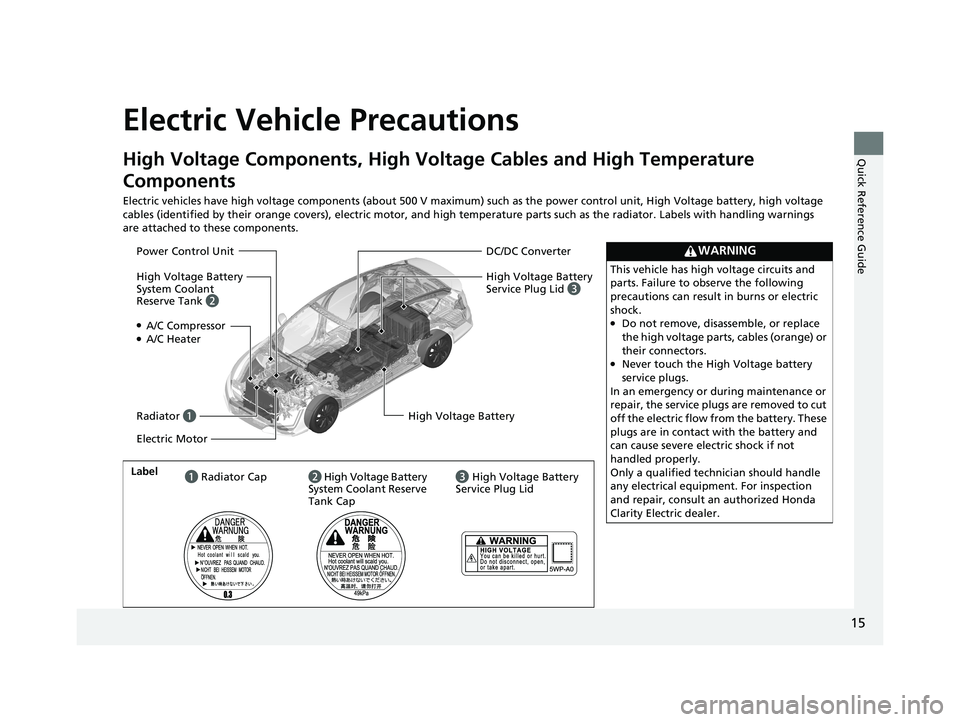
15
Quick Reference Guide
Electric Vehicle Precautions
High Voltage Components, High Voltage Cables and High Temperature
Components
Electric vehicles have high voltage components (about 500 V maximum) such as the power control unit, High Voltage battery, high voltage
cables (identified by their orange covers), electric motor, and high temperature parts such as the radiator. Labels with handli ng warnings
are attached to these components.
WARNING
This vehicle has high voltage circuits and
parts. Failure to observe the following
precautions can result in burns or electric
shock.
●Do not remove, disassemble, or replace
the high voltage parts, cables (orange) or
their connectors.
●Never touch the High Voltage battery
service plugs.
In an emergency or during maintenance or
repair, the service plugs are removed to cut
off the electric flow from the battery. These
plugs are in contact with the battery and
can cause severe electric shock if not
handled properly.
Only a qualified technician should handle
any electrical equipment. For inspection
and repair, consult an authorized Honda
Clarity Electric dealer.
DC/DC Converter
●A/C Compressor●A/C Heater
Radiator a High Voltage Battery
Label
a Radiator Cap
Power Control Unit
Electric Motor
High Voltage Battery
Service Plug Lid c
High Voltage Battery
System Coolant
Reserve Tank b
b High Voltage Battery
System Coolant Reserve
Tank Cap c
High Voltage Battery
Service Plug Lid
19 CLARITY BEV-31TRV6200.book 15 ページ 2018年10月29日 月曜日 午前10時54分
Page 18 of 559
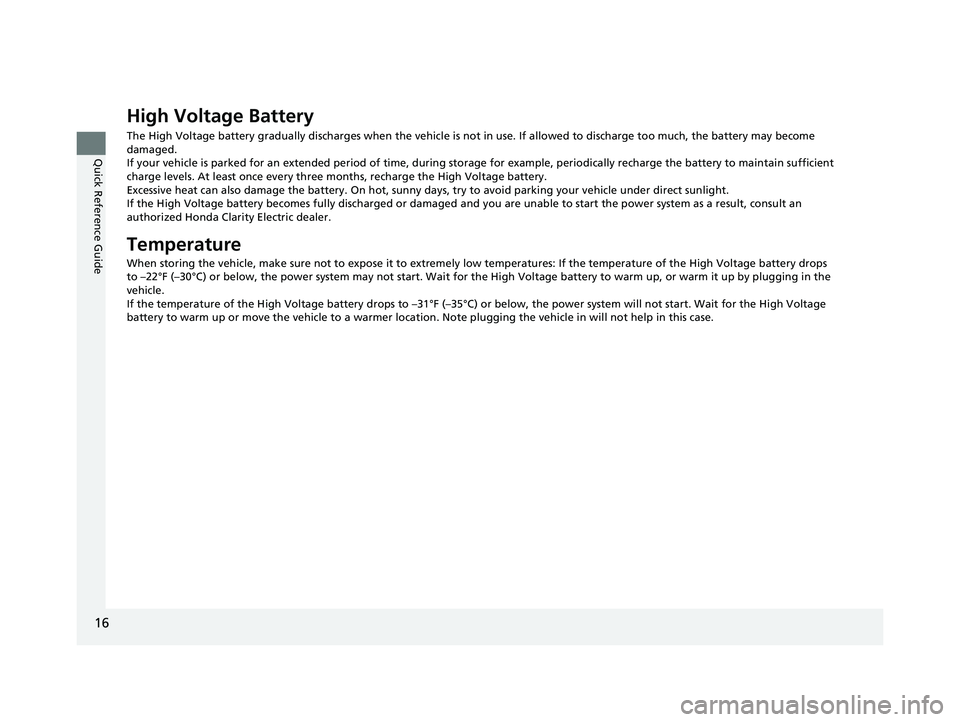
16
Quick Reference Guide
High Voltage Battery
The High Voltage battery gradually discharges when the vehicle is not in use. If allowed to discharge too much, the battery may become
damaged.
If your vehicle is parked for an extended period of time, du ring storage for example, periodically recharge the battery to main tain sufficient
charge levels. At least once every three months, recharge the High Voltage battery.
Excessive heat can also damage the batter y. On hot, sunny days, try to avoid parking your vehicle under direct sunlight.
If the High Voltage battery becomes fully discharged or damaged and you are unable to start the power system as a result, consult an
authorized Honda Clarity Electric dealer.
Temperature
When storing the vehicle, make sure not to expose it to extrem ely low temperatures: If the temperature of the High Voltage batt ery drops
to –22°F (–30°C) or below, the power system may not start. Wait for the High Voltage batt ery to warm up, or warm it up by plugging in the
vehicle.
If the temperature of the High Voltage battery drops to –31°F (– 35°C) or below, the power system will not start. Wait for the High Voltage
battery to warm up or move the vehicle to a warmer location. Note plugging the vehicle in will not help in this case.
19 CLARITY BEV-31TRV6200.book 16 ページ 2018年10月29日 月曜日 午前10時54分
Page 19 of 559
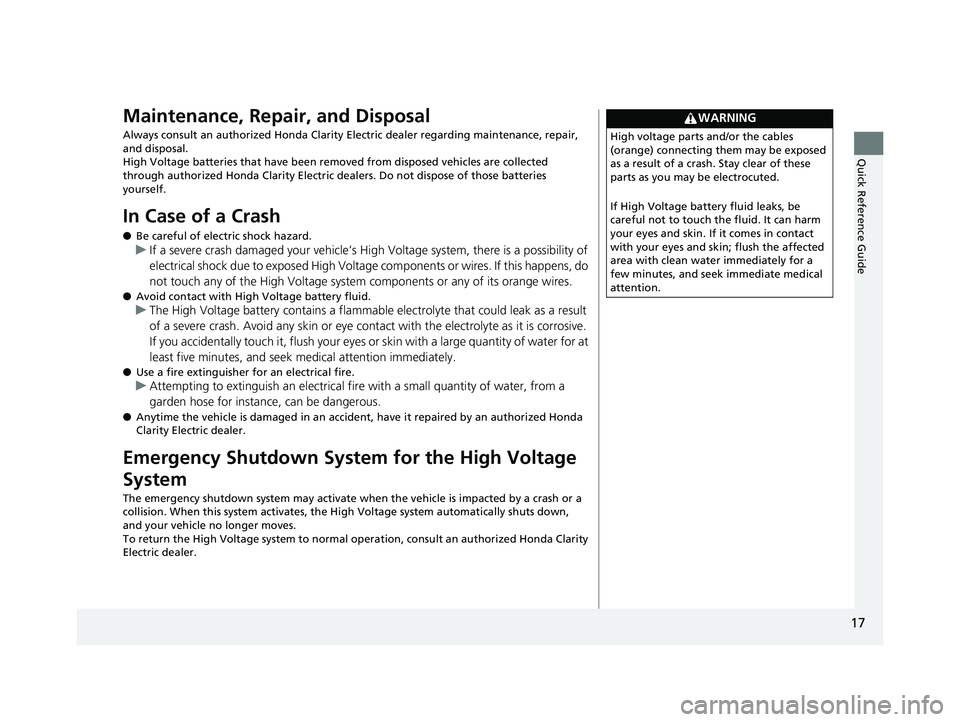
17
Quick Reference Guide
Maintenance, Repair, and Disposal
Always consult an authorized Honda Clarity Electric dealer regarding maintenance, repair,
and disposal.
High Voltage batteries that have been removed from disposed vehicles are collected
through authorized Honda Clarity Electric dealers. Do not dispose of those batteries
yourself.
In Case of a Crash
● Be careful of electric shock hazard.
uIf a severe crash damaged your vehicle’s Hi gh Voltage system, there is a possibility of
electrical shock due to exposed High Voltage components or wires. If this happens, do
not touch any of the High Vo ltage system components or any of its orange wires.
●Avoid contact with High Voltage battery fluid.
uThe High Voltage battery contains a flammabl e electrolyte that could leak as a result
of a severe crash. Avoid any skin or eye cont act with the electrolyte as it is corrosive.
If you accidentally touch it, flush your eyes or skin with a large quantity of water for at
least five minutes, and seek medical attention immediately.
● Use a fire extinguisher for an electrical fire.
uAttempting to extinguish an electrical fire with a small quantity of water, from a
garden hose for instance, can be dangerous.
● Anytime the vehicle is damaged in an accident, have it repaired by an authorized Honda
Clarity Electric dealer.
Emergency Shutdown System for the High Voltage
System
The emergency shutdown system may activate when the vehicle is impacted by a crash or a
collision. When this system activates, the High Voltage system automatically shuts down,
and your vehicle no longer moves.
To return the High Voltage syste m to normal operation, consult an authorized Honda Clarity
Electric dealer.
WARNING
High voltage parts and/or the cables
(orange) connecting them may be exposed
as a result of a crash. Stay clear of these
parts as you may be electrocuted.
If High Voltage battery fluid leaks, be
careful not to touch the fluid. It can harm
your eyes and skin. If it comes in contact
with your eyes and skin; flush the affected
area with clean water immediately for a
few minutes, and seek immediate medical
attention.
19 CLARITY BEV-31TRV6200.book 17 ページ 2018年10月29日 月曜日 午前10時54分
Page 20 of 559
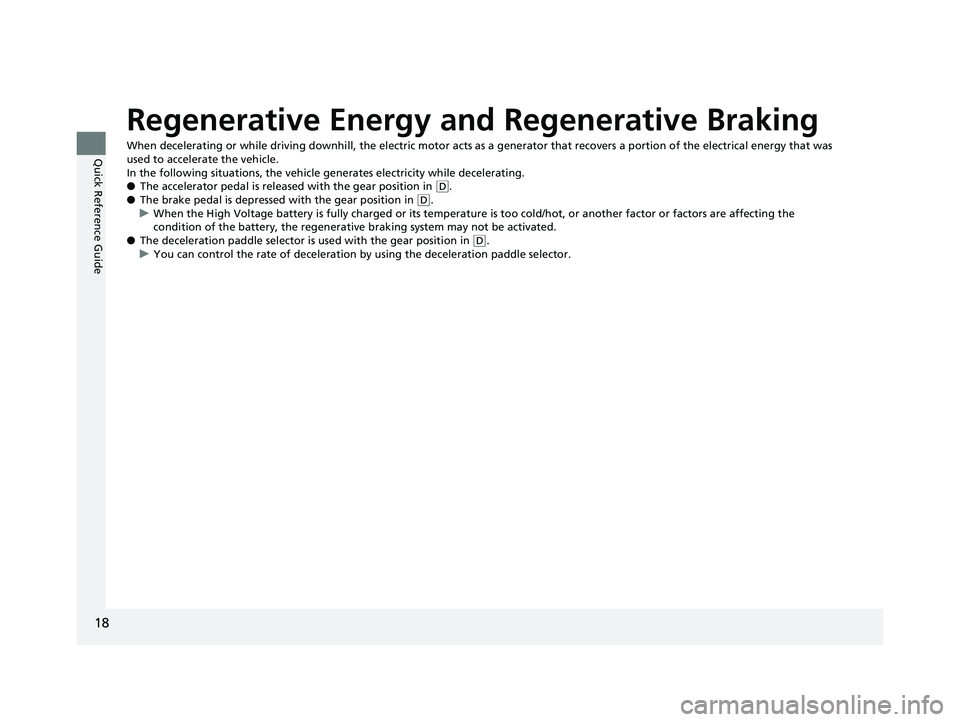
18
Quick Reference Guide
Regenerative Energy and Regenerative Braking
When decelerating or while driving downhill, the electric motor acts as a generator that recovers a portion of the electrical energy that was
used to accelerate the vehicle.
In the following situations, the vehicle generates electricity while decelerating.
● The accelerator pedal is released with the gear position in
(D.
● The brake pedal is depressed with the gear position in
(D.
u When the High Voltage battery is fully charged or its temperature is too cold/hot, or another factor or factors are affecting t he
condition of the battery, the regenerative braking system may not be activated.
● The deceleration paddle selector is used with the gear position in
(D.
u You can control the rate of deceleration by using the deceleration paddle selector.
19 CLARITY BEV-31TRV6200.book 18 ページ 2018年10月29日 月曜日 午前10時54分
Page 25 of 559
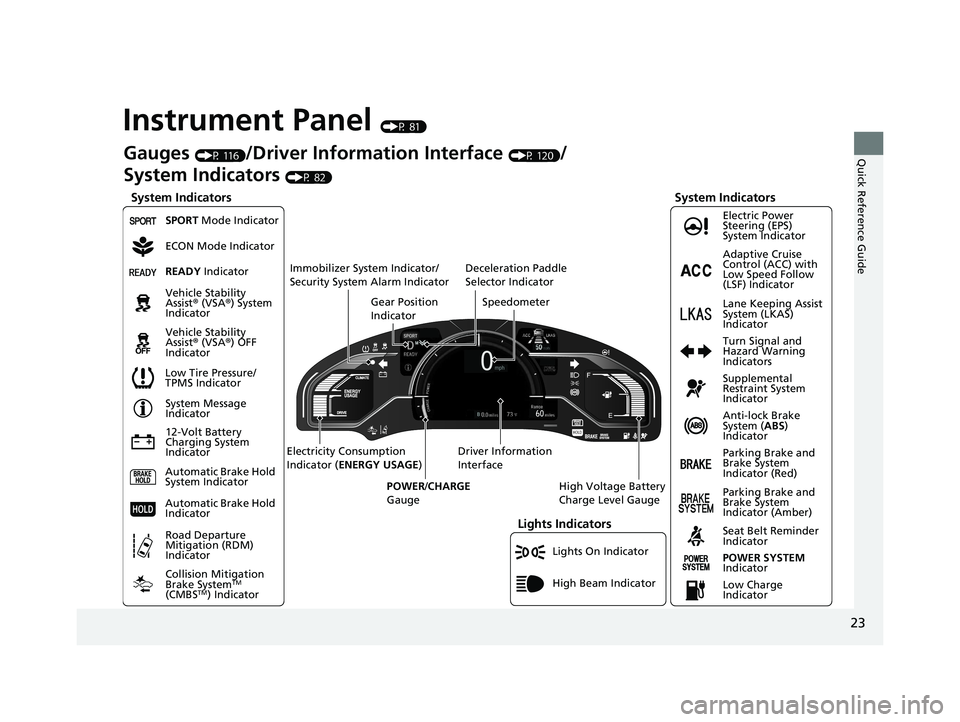
23
Quick Reference Guide
Instrument Panel (P 81)
Lights On Indicator
System Indicators
12-Volt Battery
Charging System
IndicatorAnti-lock Brake
System (
ABS)
Indicator
Vehicle Stability
Assist
® (VSA ®) System
Indicator
Vehicle Stability
Assist ® (VSA ®) OFF
Indicator Electric Power
Steering (EPS)
System Indicator
Lights Indicators
High Beam Indicator
Seat Belt Reminder
Indicator
System Indicators
System Message
Indicator
Parking Brake and
Brake System
Indicator (Red) Supplemental
Restraint System
Indicator
Gauges (P 116)/Driver Information Interface (P 120)/
System Indicators
(P 82)
Low Tire Pressure/
TPMS Indicator Turn Signal and
Hazard Warning
Indicators
Speedometer
Automatic Brake Hold
System Indicator Parking Brake and
Brake System
Indicator (Amber)
SPORT Mode Indicator
Collision Mitigation
Brake System
TM
(CMBSTM) Indicator
Road Departure
Mitigation (RDM)
Indicator
Immobilizer System Indicator/
Security System Alarm Indicator
Automatic Brake Hold
IndicatorREADY Indicator
POWER SYSTEM
Indicator
Gear Position
Indicator
High Voltage Battery
Charge Level Gauge
Driver Information
Interface
Electricity Consumption
Indicator (
ENERGY USAGE )
POWER /CHARGE
Gauge
Low Charge
Indicator Adaptive Cruise
Control (ACC) with
Low Speed Follow
(LSF) Indicator
Lane Keeping Assist
System (LKAS)
Indicator
Deceleration Paddle
Selector Indicator
ECON Mode Indicator
19 CLARITY BEV-31TRV6200.book 23 ページ 2018年10月29日 月曜日 午前10時54分
Page 36 of 559
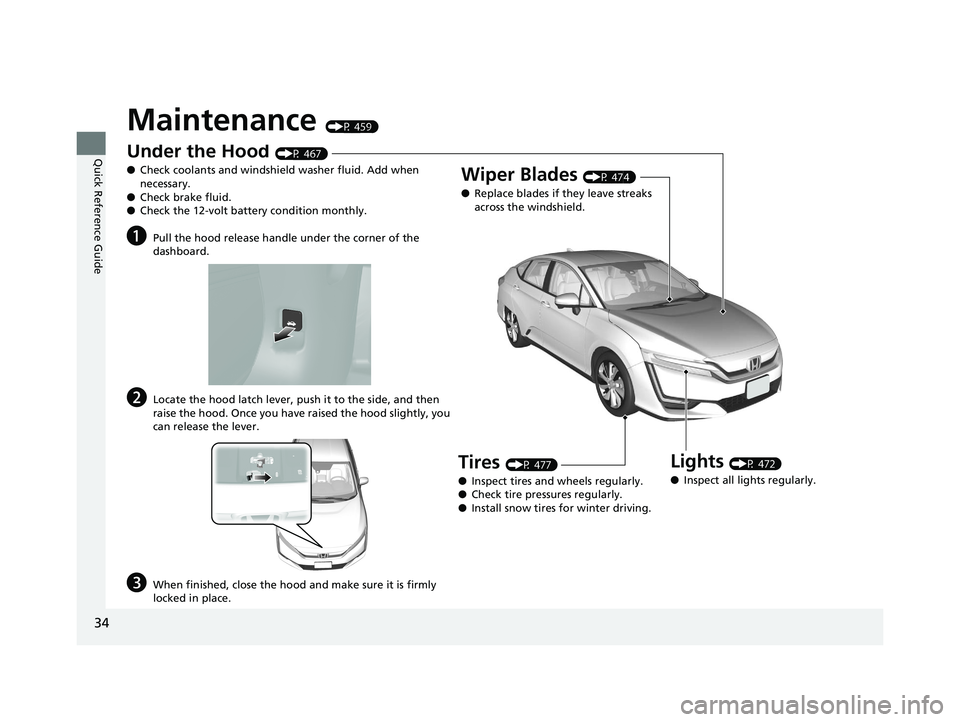
34
Quick Reference Guide
Maintenance (P 459)
Under the Hood (P 467)
● Check coolants and windshield washer fluid. Add when
necessary.
● Check brake fluid.
● Check the 12-volt battery condition monthly.
aPull the hood release handle under the corner of the
dashboard.
bLocate the hood latch lever, push it to the side, and then
raise the hood. Once you have raised the hood slightly, you
can release the lever.
cWhen finished, close the hood and make sure it is firmly
locked in place.
Lights (P 472)
● Inspect all lights regularly.
Wiper Blades (P 474)
● Replace blades if they leave streaks
across the windshield.
Tires (P 477)
● Inspect tires and wheels regularly.
● Check tire pressures regularly.
● Install snow tires for winter driving.
19 CLARITY BEV-31TRV6200.book 34 ページ 2018年10月29日 月曜日 午前10時54分